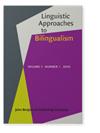双语儿童的共同句法及跨语言影响
IF 1.8
2区 文学
0 LANGUAGE & LINGUISTICS
引用次数: 1
摘要
摘要:本文探讨了结构启动在跨语言影响中的作用,这是双语语言发展的一个公认但却鲜为人知的特征。更具体地说,我们测试了跨语言影响可能被概念化为语言间启动的提议,即作为先前语言暴露(Serratrice, 2016)和语言之间共享句法表征(Hartsuiker et al., 2004)的结果。在实验1中,我们使用所有格结构(例如,宇航员的狗,宇航员的狗)在语言之间启动双语英语-荷兰儿童。在实验2中,我们使用语言内启动对同一组儿童与西班牙-荷兰双语儿童和单语荷兰儿童进行了比较。语言内启动强于语言间启动。在这两个实验中,我们研究了启动行为与语言暴露、使用和熟练程度的个体差异之间的关系。实验1发现语言间启动的持久效应受熟练程度的调节。实验2的结果与语言内启动的逆启动效应一致,该效应在一定程度上受双语儿童其他语言特性的调节。综上所述,这些发现与以下观点一致:语言间启动是支持跨语言影响的合理机制,双语儿童对两种语言中相似的结构形成了共同的句法表征。本文章由计算机程序翻译,如有差异,请以英文原文为准。
Shared syntax and cross-linguistic influence in bilingual children
Abstract This paper investigates the role of structural priming in cross-linguistic influence, a well-established yet poorly understood characteristic of bilingual language development. More specifically, we test the proposal that cross-linguistic influence may be conceptualized as between-language priming, that is, as the result of prior linguistic exposure ( Serratrice, 2016 ) and shared syntactic representations between languages ( Hartsuiker et al., 2004 ). In Experiment 1, we primed bilingual English-Dutch children between languages using possessive structures (e.g., the astronaut’s dog, the dog of the astronaut ). In Experiment 2, we compared the same group of children with bilingual Spanish-Dutch and monolingual Dutch children using within-language priming. Within-language priming was stronger than between-language priming. In both experiments, we examined the relation between priming behaviour and individual differences in language exposure, use and proficiency. Experiment 1 found between-language priming with long-lasting effects modulated by proficiency. The results of Experiment 2 were consistent with inverse priming effects in within-language priming modulated – to a degree – by properties of the bilingual children’s other language. Taken together, these findings are consistent with the proposal that between-language priming is a plausible mechanism underpinning cross-linguistic influence and that bilingual children develop shared syntactic representations for structures which are similar across their two languages.
求助全文
通过发布文献求助,成功后即可免费获取论文全文。
去求助
来源期刊

Linguistic Approaches To Bilingualism
Social Sciences-Linguistics and Language
CiteScore
3.20
自引率
9.10%
发文量
24
期刊介绍:
LAB provides an outlet for cutting-edge, contemporary studies on bilingualism. LAB assumes a broad definition of bilingualism, including: adult L2 acquisition, simultaneous child bilingualism, child L2 acquisition, adult heritage speaker competence, L1 attrition in L2/Ln environments, and adult L3/Ln acquisition. LAB solicits high quality articles of original research assuming any cognitive science approach to understanding the mental representation of bilingual language competence and performance, including cognitive linguistics, emergentism/connectionism, generative theories, psycholinguistic and processing accounts, and covering typical and atypical populations.
 求助内容:
求助内容: 应助结果提醒方式:
应助结果提醒方式:


